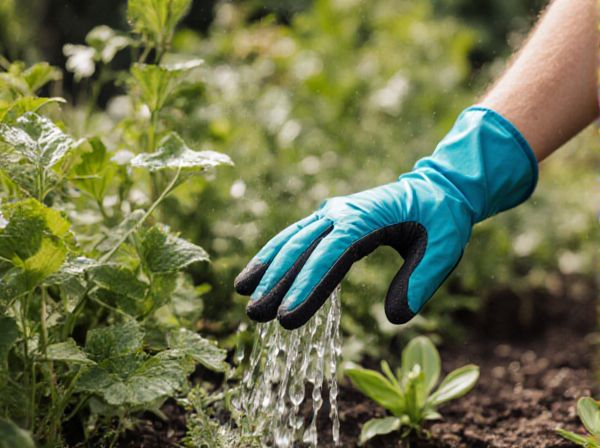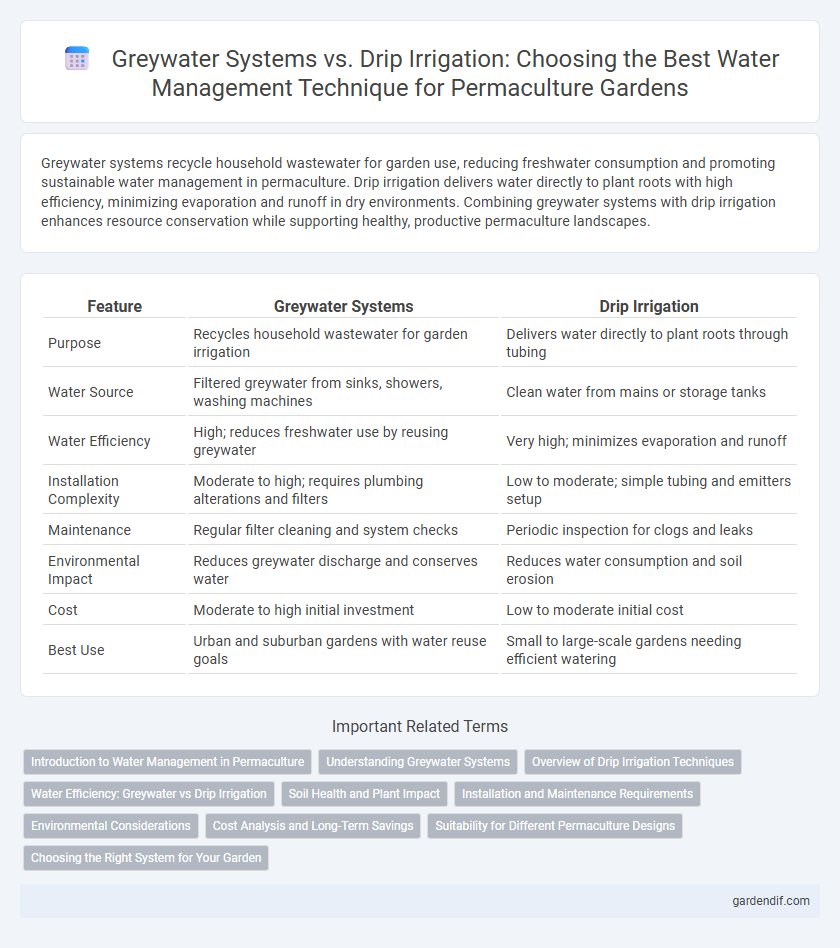
Greywater Systems vs Drip Irrigation Illustration
Greywater systems recycle household wastewater for garden use, reducing freshwater consumption and promoting sustainable water management in permaculture. Drip irrigation delivers water directly to plant roots with high efficiency, minimizing evaporation and runoff in dry environments. Combining greywater systems with drip irrigation enhances resource conservation while supporting healthy, productive permaculture landscapes.
Table of Comparison
| Feature | Greywater Systems | Drip Irrigation |
|---|---|---|
| Purpose | Recycles household wastewater for garden irrigation | Delivers water directly to plant roots through tubing |
| Water Source | Filtered greywater from sinks, showers, washing machines | Clean water from mains or storage tanks |
| Water Efficiency | High; reduces freshwater use by reusing greywater | Very high; minimizes evaporation and runoff |
| Installation Complexity | Moderate to high; requires plumbing alterations and filters | Low to moderate; simple tubing and emitters setup |
| Maintenance | Regular filter cleaning and system checks | Periodic inspection for clogs and leaks |
| Environmental Impact | Reduces greywater discharge and conserves water | Reduces water consumption and soil erosion |
| Cost | Moderate to high initial investment | Low to moderate initial cost |
| Best Use | Urban and suburban gardens with water reuse goals | Small to large-scale gardens needing efficient watering |
Introduction to Water Management in Permaculture
Greywater systems recycle household wastewater from sinks, showers, and laundry to irrigate plants, conserving freshwater resources and enhancing soil moisture retention. Drip irrigation delivers precise amounts of water directly to plant roots, minimizing evaporation and runoff while optimizing water efficiency in permaculture gardens. Both techniques are essential in sustainable water management strategies, promoting resource conservation and improving plant health in permaculture designs.
Understanding Greywater Systems
Greywater systems recycle household wastewater from sinks, showers, and laundry to irrigate gardens, reducing freshwater consumption and supporting sustainable water management in permaculture. These systems require filtration and careful management to prevent contamination, making them more complex but highly efficient for water reuse. Understanding the balance between graywater quality and appropriate plant selection is essential for maximizing soil health and crop yield in permaculture designs.
Overview of Drip Irrigation Techniques
Drip irrigation techniques deliver water directly to the root zone of plants through a network of valves, pipes, tubing, and emitters, maximizing water efficiency and reducing evaporation. This method supports sustainable water management in permaculture by conserving resources and promoting healthy plant growth. Precise control of water application minimizes runoff and soil erosion, enhancing soil moisture retention and nutrient availability.
Water Efficiency: Greywater vs Drip Irrigation
Greywater systems recycle household wastewater for irrigation, significantly reducing potable water use by up to 50%, making them a sustainable option for permaculture gardens. Drip irrigation delivers water directly to plant roots with precision, minimizing evaporation and runoff, achieving water use efficiency rates as high as 90%. Combining greywater reuse with drip irrigation maximizes water conservation, promoting resilient and eco-friendly permaculture practices.
Soil Health and Plant Impact
Greywater systems recycle household wastewater to irrigate plants, enhancing soil moisture retention and nutrient content by introducing organic matter without harmful chemicals. Drip irrigation delivers precise water amounts directly to the root zone, minimizing soil erosion and water loss while promoting healthy root development and reducing plant stress. Both methods improve water efficiency, but greywater systems contribute additional soil enrichment, whereas drip irrigation ensures optimal hydration for plant growth and sustainable soil health.
Installation and Maintenance Requirements
Greywater systems require careful installation involving plumbing modifications to safely redirect household wastewater for garden use, along with regular maintenance to prevent clogging and bacterial buildup. Drip irrigation setups are generally easier to install, involving laying tubing and emitters throughout planting areas, and demand periodic checks for leaks and emitter blockages. Both systems benefit from routine inspections to ensure efficient water delivery and sustainability in permaculture gardens.
Environmental Considerations
Greywater systems reuse household wastewater for irrigation, significantly reducing freshwater consumption and minimizing wastewater discharge, thus lowering environmental impact. Drip irrigation conserves water by delivering precise amounts directly to plant roots, enhancing water efficiency and reducing runoff and soil erosion. Implementing both in permaculture designs promotes sustainable water management and supports ecosystem health by optimizing resource use and reducing pollution.
Cost Analysis and Long-Term Savings
Greywater systems typically require an initial investment ranging from $500 to $2,500, depending on complexity, but they reduce freshwater use by recycling household wastewater, leading to significant water bill savings over time. Drip irrigation systems cost between $200 and $1,000 upfront and offer precise water delivery that minimizes evaporation and runoff, resulting in efficient water usage and lower operational costs. Long-term, greywater systems can provide greater sustainability benefits and reduce dependence on municipal water, while drip irrigation excels in reducing water usage in agriculture and gardening, making each option cost-effective based on specific permaculture goals.
Suitability for Different Permaculture Designs
Greywater systems are ideal for permaculture designs emphasizing water recycling and sustainability, providing a reliable source of filtered household wastewater for irrigating hardy plants and trees, especially in arid environments. Drip irrigation suits intensive food forests and garden beds requiring precise water delivery to root zones, maximizing water use efficiency and reducing runoff. Choosing between these systems depends on landscape topography, water availability, plant types, and the desired balance between resource conservation and crop productivity.
Choosing the Right System for Your Garden
Greywater systems reuse household wastewater to irrigate plants, reducing freshwater consumption and promoting sustainable water management in permaculture gardens. Drip irrigation delivers water directly to the plant roots with precision, minimizing evaporation and runoff while enhancing water efficiency. Selecting the right system depends on factors such as water availability, soil type, plant species, and maintenance capacity to optimize resource use and garden health.
Greywater Systems vs Drip Irrigation Infographic

 gardendif.com
gardendif.com